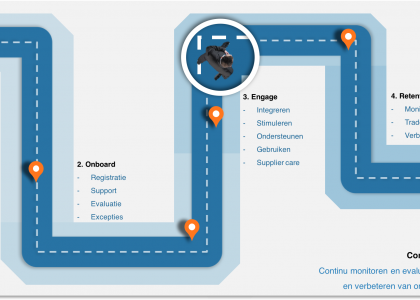Can your organisation receive e-invoices, but is the number of suppliers sending e-invoices still limited? The summer holidays are a good time to start working on your supplier onboarding strategy, so that you can start receiving more e-invoices immediately after the summer.
When you first start transitioning your suppliers to e-invoicing (supplier onboarding), it is important to start with a good onboarding strategy. After all, onboarding your suppliers is not just a matter of sending an e-mail. There are many more aspects to it. In this blog article, we focus on a few important points. More detailed information can be found in our white papers ‘Onboarding van leveranciers: Tips & Tricks’ and ‘Samerwerken3’ (available in Dutch).
For organisations that have been onboarding suppliers for some time, without the desired results, it is a good idea to review the onboarding strategy. The strategy can be further optimised on the basis of experience gained and reactions from suppliers.
Supplier onboarding is an ongoing process that requires considerable effort and resources from an organisation. As an organisation, you can choose to do the onboarding yourself, but it is also possible to outsource it.
Which suppliers would you like to onboard first?
To start with, it is good to have a list of suppliers from whom you do not yet receive e-invoices. You can add to this list the number of invoices you have received from each supplier in the past year. By getting suppliers who deliver a lot of invoices to switch to e-invoicing, you can quickly save a lot of time. In addition, those who send a limited number of invoices can sometimes create a lot of work. For example, if data is often missing from the invoice and the supplier must then be contacted. It can therefore also be very interesting for these smaller suppliers to switch to e-invoicing.
See the move to e-invoicing from your supplier’s point of view
You would like to receive e-invoices from your supplier, but what does he get in return? You could consider, for example, whether it is possible to give suppliers a certain discount, guarantee timely payment or even pay earlier. This extra incentive makes it more attractive for them to look into the possibilities of sending e-invoices.
Make it as easy as possible to deliver e-invoices
Not all suppliers know what e-invoicing is or how to send an e-invoice. So supplier onboarding is more than just asking if they want to send an e-invoice. Suppliers are often quite willing to accommodate their customers, but the chances are small that they will implement software for your organisation and incur costs. Sending an UBL invoice is already possible in many software packages. However, suppliers are not always aware of this. It is therefore likely that, for many of them, providing an e-invoice is just a matter of ticking a box.
Format e-invoice
Your own organisation can do a lot to keep it simple for your supplier. Most software packages can send a UBL, but there are many different types of UBLs. So it may well be that your supplier sends you an e-invoice but your software cannot process it. To avoid these problems, it is wise to have your incoming e-invoices converted by a service provider (such as tradeinterop). With the help of format conversion, the e-invoices you receive, such as various types of UBLs, but also HR-XML, INSBOU, SAP iDoc etc. are converted to the format that your own software can process.
Delivery channel
In addition to the format, there is also the channel through which e-invoices are sent. In the Netherlands, most e-invoices are sent via e-mail and Peppol. However, there are other ways to exchange e-invoices. Here too, a service provider can help you by making it possible to receive e-invoices via different channels.
It is also good to take into account organisations that cannot send e-invoices, for example because they do not use accounting software or their software cannot send e-invoices. You can then offer them an e-invoicing portal to create an e-invoice.
So there are several ways to make the delivery of e-invoices as easy as possible for your supplier. This makes the switch a lot easier for them and increases the chance that they will actually send e-invoices.
Do you want to know more about supplier onboarding? Then read on here.




